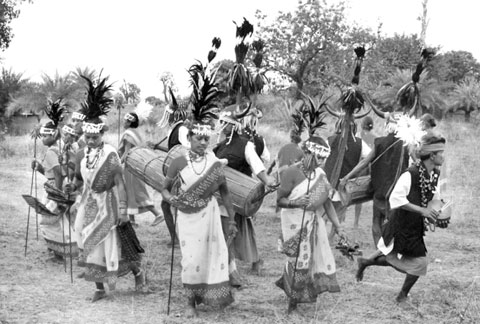Tribal dance - its origin and forms
By Amal Hewavissenti
Dancing, which could be roughly defined as the performance of a
rhythmic and patterned succession of steps usually to music, is really a
powerful human need. Dancing forms in any country reflect the culture
and the inherent nature of the people living in it. Practically, dancing
focuses much more on achieving health by slow or vigorous rhythmic
activity and serves as a surprisingly entertaining form of art.
It proves that 'movement' of body is more powerful, more significant
and more explicit than verbalisation of feelings and moods. Dancing in
fact symbolises the rhythm of heart - the pulse of the population in a
given country whatever culture or ethnic variety they belong to. A
dancer can better give free expression to his expectations, moods,
feelings and desires through the medium of dance and is in an excellent
preparation to provide entertainment.
 No precise calculation has thus far made as to how many dance forms
have existed or exist in among numerous ethnic groups and tribal
societies in the world. However, a myriad of dance forms must be in
existence within the cultural and geographical boundaries of people with
their unique identities underlined. No precise calculation has thus far made as to how many dance forms
have existed or exist in among numerous ethnic groups and tribal
societies in the world. However, a myriad of dance forms must be in
existence within the cultural and geographical boundaries of people with
their unique identities underlined.
Dancing figures prominently in all fine arts because it is the oldest
form of art which does not exploit any instrument except for the body.
Man has been immensely attracted to this form of art because man's life
is purely characterised by rhythm in everything from his heart beat to
the process of breathing. It has evolved with beliefs, customs, social
etiquette and attitudes of the population of all regions and has been
nourished by each variety that is typical to any particular terrain or a
group of people.
We could safely infer that the most primitive dance originated within
a sacred background and with a variety of magic, rites and rituals
simply to please the invisible god. Thereafter, dancing as a primitive
art evolved giving people the basic assurance of fulfilling a
multiplicity of needs. The earliest dance was purely a worship of
natural phenomena which were subsequently regarded as gods.
The sketchy paintings discovered in the caves of Spain and Seychelles
are the best instances of the origin of dance. The prehistoric paintings
of Seychelles feature a group dance by naked members of a family that
presumably performs a religious rite. The members of the dancing group
display varied postures and gestures in the performance of their
exclusive religious dance.
Tribal dance
Diverse dancing styles by tribes living in Amazon forest and Africa
are closely linked with the immediate life of tribesmen and their rich
heritage of ancient tribal customs. Their dances are meant to invoke
blessings from the forces of nature and sometimes to celebrate special
events pivotal to their lives. Eventhough much of tribal dance concerns
with aspects of entertainment, this form of dance is often performed to
obtain protection from illnesses, foreign invasions and natural
disasters. Furthermore, the tribesmen dance to obtain assurance for food
and fertility, and the development of their community.
Dances of diverse tribes
The Australian aborigines, North American Indians and tribesmen of
New Mexico and Arizona perform a special dance called Magico Religious
dance which invites rain to soak the drought stricken areas. The Kachina
the dance performed by Mexicans invokes the forces of nature to bring in
enough rain and fertilise their lands.
Entertainment
For tribesmen, dancing is a powerful medium of expressing their
emotions and is a unique method to imitate diverse concepts, voices and
movements of mother nature. Tribesmen at all times employ dancing as a
source of entertainment specially during social functions and
celebrations of special milestones of their lives within their tribal
culture.
The dance called Jaram Thepam which is a famous Indonesian dance
include two dancers who rhythmically imitates horse riders. The dance
"Leghorn" commonly performed in the island of Baali purely conveys
secular themes acted out by two young ladies. The dances performed by
various gypsy groups throughout the world specially the folk dance
called Faminco performed by Spanish gypsies are considered really
impressive non religious tribal dances. Here, the "Rope dance" performed
by Persians and Hungarian tribesmen deserves a special notice. However,
the primitive tribal dances gave birth to the modern entertaining
dances, folk dances and ethnic dances that evolved along with other
forms of dance.
Other dances
The tribesmen strongly believe that the dead live with them in the
form of spirits and that they should be appeased in order to escape from
all evil influences possibly exerted by the dead. Thus, a dance for the
dead came into existence.
The medicine dance prevalent among Siberian and Red Indian tribes is
performed to cure a member of certain disease. During this dance, the
medicine men takes upon himself the power of spirits and performs a
violent movements (in order to produce a healing effect on the patient).
In Rumania, ladies perform a chain dance round the patient (Rumanian
Calusari dance) in order to express gratitude to invisible forces for
curing the particular patient. The chain dance, Ring dance and specially
the pair dance in Luxor, Egypt featured people dancing face to face.
These dances later developed the concept of Ballroom dance which is a
highly popular form of dance in civilised society.
|



